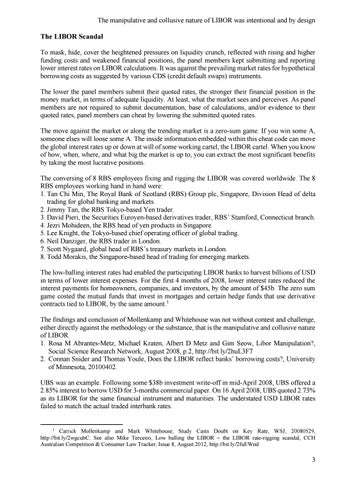The manipulative and collusive nature of LIBOR was intentional and by design
The LIBOR Scandal To mask, hide, cover the heightened pressures on liquidity crunch, reflected with rising and higher funding costs and weakened financial positions, the panel members kept submitting and reporting lower interest rates on LIBOR calculations. It was against the prevailing market rates for hypothetical borrowing costs as suggested by various CDS (credit default swaps) instruments. The lower the panel members submit their quoted rates, the stronger their financial position in the money market, in terms of adequate liquidity. At least, what the market sees and perceives. As panel members are not required to submit documentation, base of calculations, and/or evidence to their quoted rates, panel members can cheat by lowering the submitted quoted rates. The move against the market or along the trending market is a zero-sum game. If you win some A, someone elses will loose some A. The inside information embedded within this cheat code can move the global interest rates up or down at will of some working cartel, the LIBOR cartel. When you know of how, when, where, and what big the market is up to, you can extract the most significant benefits by taking the most lucrative positions. The conversing of 8 RBS employees fixing and rigging the LIBOR was covered worldwide. The 8 RBS employees working hand in hand were: 1. Tan Chi Min, The Royal Bank of Scotland (RBS) Group plc, Singapore, Division Head of delta trading for global banking and markets. 2. Jimmy Tan, the RBS Tokyo-based Yen trader. 3. David Pieri, the Securities Euroyen-based derivatives trader, RBS’ Stamford, Connecticut branch. 4. Jezri Mohideen, the RBS head of yen products in Singapore. 5. Lee Knight, the Tokyo-based chief operating officer of global trading. 6. Neil Danziger, the RBS trader in London. 7. Scott Nygaard, global head of RBS’s treasury markets in London. 8. Todd Morakis, the Singapore-based head of trading for emerging markets. The low-balling interest rates had enabled the participating LIBOR banks to harvest billions of USD in terms of lower interest expenses. For the first 4 months of 2008, lower interest rates reduced the interest payments for homeowners, companies, and investors, by the amount of $45b. The zero sum game costed the mutual funds that invest in mortgages and certain hedge funds that use derivative contracts tied to LIBOR, by the same amount.1 The findings and conclusion of Mollenkamp and Whitehouse was not without contest and challenge, either directly against the methodology or the substance, that is the manipulative and collusive nature of LIBOR. 1. Rosa M Abrantes-Metz, Michael Kraten, Albert D Metz and Gim Seow, Libor Manipulation?, Social Science Research Network, August 2008, p.2, http://bit.ly/2huL3F7 2. Connan Snider and Thomas Youle, Does the LIBOR reflect banks’ borrowing costs?, University of Minnesota, 20100402. UBS was an example. Following some $38b investment write-off in mid-April 2008, UBS offered a 2.85% interest to borrow USD for 3-months commercial paper. On 16 April 2008, UBS quoted 2.73% as its LIBOR for the same financial instrument and maturities. The understated USD LIBOR rates failed to match the actual traded interbank rates.
1 Carrick Mollenkamp and Mark Whitehouse, Study Casts Doubt on Key Rate, WSJ, 20080529, http://bit.ly/2wgcubC. See also Mike Terceiro, Low balling the LIBOR – the LIBOR rate-rigging scandal, CCH Australian Competition & Consumer Law Tracker, Issue 8, August 2012, http://bit.ly/2fuEWnd
3
